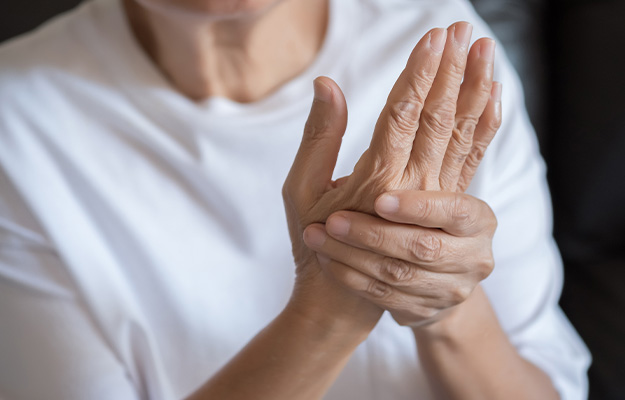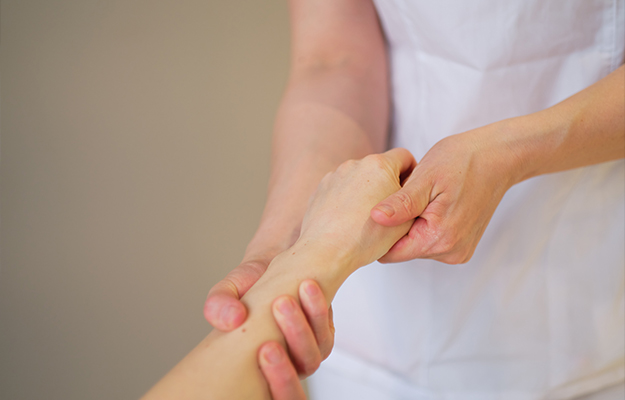Osteoarthritis, often termed “wear-and-tear” arthritis, is a prevalent joint condition that afflicts millions of individuals worldwide. Yet, within this spectrum of joint diseases exists a more sinister and debilitating variant known as erosive osteoarthritis (EOA).
Read on to learn about erosive osteoarthritis, its causes and symptoms, and how to cope while living well and freeing yourself from suffering.
Understanding the Elevated Risks of Erosive Osteoarthritis | Why It is More Dangerous
What is Erosive Osteoarthritis?

Erosive osteoarthritis is a more severe form of osteoarthritis. It gets its name from the erosion or damage it causes to the bones and cartilage within the affected joints.
Unlike its milder counterparts, such as osteoarthritis or rheumatoid arthritis, erosive osteoarthritis inflicts a more profound impact on a person’s mobility and quality of life.
While these conditions share some features, such as joint pain, stiffness, and reduced function, erosive osteoarthritis is more aggressive and destructive.
What Causes Erosive Osteoarthritis?
The exact cause of erosive osteoarthritis remains a subject of ongoing debate in the medical community. Scientists are still piecing together the puzzle of its origins, trying to determine whether it primarily results from aging or if there’s something else involved.
Age is undoubtedly a critical factor.
As we grow older, the wear and tear on our joints accumulate. This process can lead to the development of regular osteoarthritis. However, erosive osteoarthritis is not limited to older adults. According to the CDC, 7.1% of adults in the United States aged 18 to 44 reported some kind of arthritis from 2016 to 2018.
This finding suggests that age alone cannot explain its occurrence.
One striking aspect is that individuals with osteoarthritis are at a greater risk of developing erosive osteoarthritis over time. According to BMJ Journals, erosive osteoarthritis affects 2.8% of the population. However, the prevalence rises to 10.2% among those with symptomatic hand osteoarthritis.
Is Erosive Osteoarthritis an Autoimmune Disease?
The autoimmune theory suggests that erosive osteoarthritis may involve the immune system mistakenly attacking the joints, causing inflammation and erosion.
Researchers have found evidence of immune system involvement in erosive osteoarthritis, similar to autoimmune diseases like rheumatoid arthritis. However, more research is needed to establish a clear link between autoimmunity and erosive osteoarthritis.
What is clear is that erosive osteoarthritis shares similarities with autoimmune diseases. It combines the joint degeneration observed in osteoarthritis with the inflammation seen in autoimmune disorders. This fusion of characteristics makes diagnosing and treating erosive osteoarthritis a challenging task.
Erosive Osteoarthritis Symptoms
Erosive osteoarthritis presents a constellation of symptoms that significantly impact an individual’s daily life.
- Joint pain is the most common complaint, often accompanied by stiffness, swelling, and decreased range of motion.
- Unlike regular osteoarthritis, erosive osteoarthritis affects multiple joints simultaneously, making it even more debilitating.
- The erosion can lead to deformities of the interphalangeal joints, causing fingers and toes to twist and become misshapen.
Erosive osteoarthritis affects mobility and the ability to perform everyday tasks like gripping objects or walking comfortably. The pain and disfigurement can have a profound psychological impact, leading to depression and reduced quality of life.
Is Erosive Osteoarthritis a Disability?
Erosive osteoarthritis can be considered a disability, given its profound effects on mobility and quality of life. While it may not be as widely recognized as other forms of arthritis, such as osteoarthritis or rheumatoid arthritis, its disabling nature is undeniable.
As shown above, statistics have underlined the seriousness of erosive osteoarthritis, suggesting that 10.2% of individuals with osteoarthritis may develop erosive osteoarthritis. This finding equates to millions of people worldwide grappling with it every day.
How Fast Does Erosive Osteoarthritis Progress?
Erosive osteoarthritis can progress at varying rates. Like other forms of arthritis, it has distinct stages that provide insight into its progression. The speed at which erosive osteoarthritis advances generally follows a predictable pattern.
- The initial stage is characterized by joint pain and stiffness, which can develop gradually over months or even years. In this early phase, individuals might dismiss their symptoms as signs of normal aging or regular osteoarthritis.
- In the second stage, erosive osteoarthritis becomes more aggressive. Joint deformities start to manifest, particularly in the hands and fingers. The erosions within the joints become more pronounced, leading to the characteristic bone and cartilage damage. Depending on the individual, this stage can develop within a few months to a couple of years from the onset of symptoms.
- In the third stage, the damage becomes more severe. Joint deformities can become disabling, affecting a person’s ability to perform even basic tasks. Mobility becomes severely limited, and the pain intensifies. By this stage, erosive osteoarthritis has already caused irreversible damage to the affected joints.
When Does Erosive Osteoarthritis Stop Progressing?
The most challenging aspect of erosive osteoarthritis is that it is a progressive disorder without a cure. It does not stop on its own, and the damage it inflicts is irreversible. Once erosions and deformities have developed, they are challenging to repair.
While medical interventions are available to manage symptoms and slow the progression, they cannot entirely halt the disease’s advancement. Therefore, individuals with erosive osteoarthritis must seek early diagnosis and treatment to minimize the extent of joint damage and maximize their quality of life.
Erosive Osteoarthritis Treatment

Managing erosive osteoarthritis involves a multifaceted approach to reduce pain and inflammation and slow disease progression. Treatment options may include:
- Medications: Nonsteroidal anti-inflammatory drugs (NSAIDs) can help reduce pain and ease inflammation. Disease-modifying antirheumatic drugs (DMARDs) may be prescribed to manage autoimmune-related components. Pain relievers, such as acetaminophen, can also provide relief.
- Physical and Occupational Therapy: These therapies can help improve joint function and maintain mobility. Therapists may recommend exercises to strengthen muscles around the affected joints and provide strategies for daily activities.
- Heat and Cold Therapy: Heat applications can ease stiffness and improve blood flow, while cold packs can help reduce inflammation and numb pain.
- Assistive Devices: Using assistive devices like braces, splints, or orthotics can support affected joints and reduce strain.
- Injections: Corticosteroid injections can provide temporary relief by reducing inflammation. Hyaluronic acid injections may be used to lubricate the joint.
Erosive Osteoarthritis Diet
Diet is crucial in managing erosive osteoarthritis. A balanced diet can help maintain a healthy weight, essential for reducing the stress on weight-bearing joints.
Some dietary guidelines for individuals with erosive osteoarthritis include:
- Anti-Inflammatory Foods: Incorporating foods rich in omega-3 fatty acids, such as salmon and walnuts, can help reduce inflammation. Fruits, vegetables, and whole grains provide essential vitamins and antioxidants.
- Weight Management: Maintaining a healthy weight is crucial. Excess weight places added stress on joints, exacerbating symptoms. A diet that supports weight loss can significantly improve mobility and reduce pain.
- Hydration: Staying hydrated is essential for joint health. Proper hydration helps maintain the fluid that lubricates the joints.
- Limiting Trigger Foods: Some individuals find that certain foods, such as those high in purines (found in organ meats and some seafood), can trigger flare-ups of arthritis symptoms. It may be beneficial to identify and avoid such trigger foods.
Supplements for Erosive Osteoarthritis
Supplements can be a complementary approach to managing erosive osteoarthritis, though they should be used under the guidance of a healthcare provider. Some supplements that may have potential benefits include:
- Glucosamine and Chondroitin: These supplements may help support joint health and reduce pain in some individuals.
- Turmeric/Curcumin: Known for its anti-inflammatory properties, turmeric or curcumin supplements may relieve joint pain and stiffness.
- Omega-3 Fatty Acids: Fish oil supplements can reduce inflammation and improve joint function.
- Vitamin D: Adequate vitamin D levels are essential for bone health. Some individuals with erosive osteoarthritis may benefit from vitamin D supplements, especially if they have a deficiency.
When is Surgery for Erosive Osteoarthritis Necessary?
Surgery for erosive osteoarthritis becomes necessary when joint deformities severely disrupt a person’s daily life. In these severe cases, surgical intervention repairs or replaces damaged joints, allowing the patient to resume daily activities.
Surgery for erosive osteoarthritis aims to alleviate pain, improve joint function, and enhance overall quality of life when non-surgical treatments prove insufficient in managing the condition’s impact on mobility and comfort.
Bottom Line
Erosive osteoarthritis is the most dangerous among joint diseases, spreading a severe impact on those affected. With its debilitating symptoms, erosive osteoarthritis emerges not just as a medical condition but as a life-altering challenge that demands increased awareness, research, and support for those who face its daily struggles.

